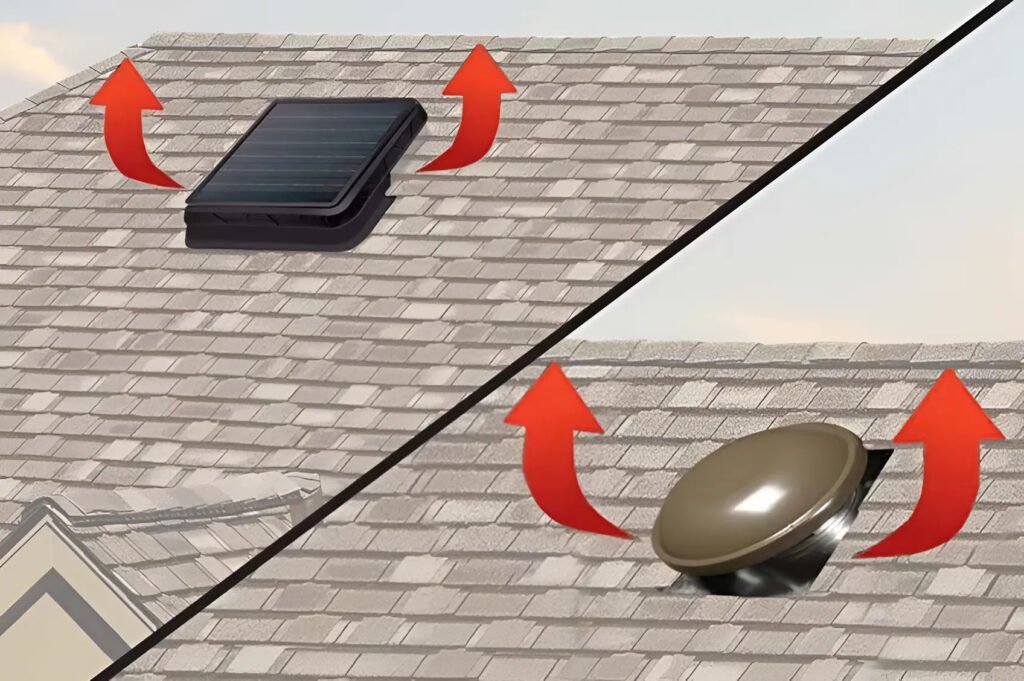Roof Ventilation Installation Guide: Best Practices for Longevity
A roof’s lifespan isn’t just about shingles—it’s about the air you can’t see. Poor ventilation traps heat and moisture, rotting decking, warping shingles, and spiking energy bills. Here’s how to design and install a ventilation system that protects your home for decades.
Why Roof Ventilation Installation is Non-Negotiable
The Science of Airflow
- Heat Reduction: Attic temps over 150°F bake shingles, cutting asphalt lifespan by 40% (GAF Research).
- Moisture Control: Trapped humidity rots wood and breeds mold—costing $5K+ in repairs.
- Energy Efficiency: Proper airflow slashes AC costs by 10–15% (ENERGY STAR).
Case Study: A CertainTeed study found balanced ventilation extends roof life by 8–12 years.
Comparing Vent Types: Ridge, Power, & Soffit Vents
| Type | Pros | Cons | Best For |
|---|---|---|---|
| Ridge Vents | Seamless, no power needed | Requires soffit vents for intake | Sloped roofs, aesthetic focus |
| Power Vents | Forces airflow, ideal for stagnant attics | Higher cost, energy use | Flat roofs, humid climates |
| Soffit Vents | Hidden, continuous intake | Can clog with insulation/debris | Homes with wide eaves |
1. Ridge Vents
- Installation: Cut a 1–2″ slot along the roof ridge; cover with vent material.
- Top Pick: Owens Corning VentSure® with built-in weather filters.
2. Power Vents
- Installation: Roof-mounted fans wired to thermostat/humidistat.
- Top Pick: Quarrix SolarFlow solar-powered, no wiring needed.
3. Soffit Vents
- Installation: Space 8–10′ apart under eaves; pair with ridge vents.
- Top Pick: TAMKO IntakePro with insect screens.
5 Costly Roof Ventilation Installation Mistakes
1. Ignoring the 1:300 Rule
- Code Requirement: 1 sq. ft. of vent per 300 sq. ft. of attic space.
- Fix: Use RoofingCalc to balance intake/exhaust.
2. Blocking Soffit Vents
- Mistake: Insulation or storage obstructs airflow.
- Fix: Install baffles like DCI Product’s SmartBaffle.
3. Mixing Vent Types
- Risk: Ridge + gable vents create “short-circuiting” (air exits before cooling attic).
- Fix: Stick to one exhaust type (ridge or gable).
4. Skipping Air Sealing
- Mistake: Vents drafty attics waste energy.
- Fix: Seal gaps with TopShield FlexSeal before installing vents.
5. Wrong Vent Placement
- Mistake: Exhaust vents too low; intake vents too high.
- Fix: Place ridge vents at peak; soffit vents at lowest eaves.
Step-by-Step Roof Ventilation Installation
- Calculate Needs: Use GAF Ventilation Calculator.
- Choose Vent Types: Match to climate and roof design.
- Cut Openings: Follow manufacturer specs (e.g., 1″ slot for ridge vents).
- Install Vents: Secure with roofing nails/sealant; ensure no gaps.
- Test Airflow: Use smoke pellets or thermal cameras post-installation.
Need a Pro?
USA Supplies connects homeowners with certified contractors specializing in code-compliant ventilation systems and energy audits.
Still unsure which vents suit your roof? Describe your home’s specs below for tailored advice!
